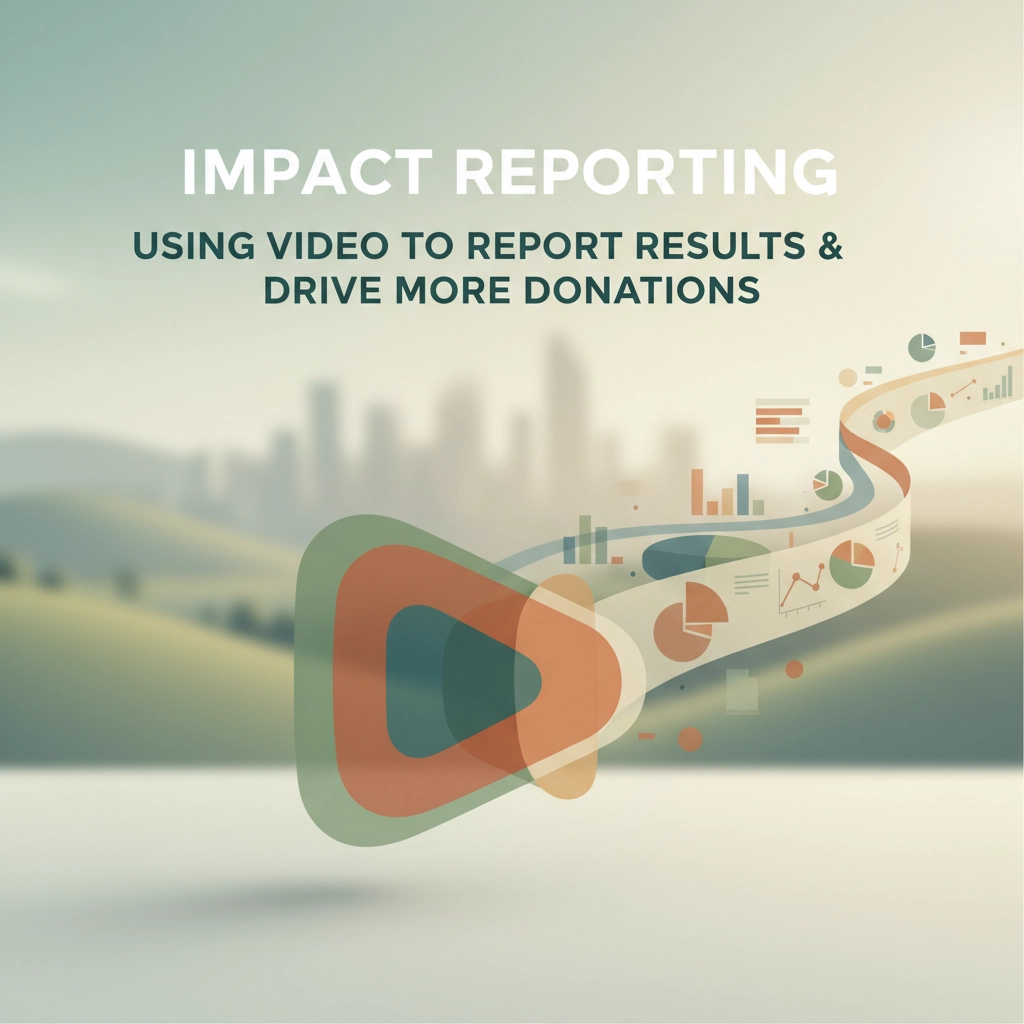Impact Reporting: Using Video to Report Results & Drive More Donations

Here's the truth: your annual impact report is probably collecting digital dust in someone's downloads folder right now.
You spent months compiling data, crafting the perfect narrative, and designing beautiful infographics. But guess what? Most donors aren't reading it. They're skimming at best, and more likely, they're not engaging with it at all.
But here's where things get interesting, when nonprofits switch from text-heavy reports to video-driven impact stories, something magical happens. Donations don't just increase, they skyrocket. We're talking about a 72% increase in donor likelihood to contribute after watching impact videos, according to recent fundraising data.
So why aren't more Canadian nonprofits using video for impact reporting? Let's dive in.
Why Your Brain Loves Video (And Your Donors Do Too)
Think about the last time you tried to explain something complex to a friend. Did you pull out a 20-page document, or did you tell them a story?
Your brain processes visual information 60,000 times faster than text. When someone watches your impact video, they retain 95% of your message. Compare that to the measly 10% they remember from reading your written report. That's not a small difference, that's a game-changer.
The SickKids Foundation in Toronto figured this out early. Instead of flooding donors with statistics about patient outcomes, they started sharing video stories of real families whose lives were transformed. The result? Their campaigns consistently outperform industry benchmarks, with individual videos garnering millions of views and driving substantial increases in both one-time and recurring donations.

The Donation Psychology Behind Video Impact Reports
Let's get real about how people make donation decisions. It's not spreadsheets and pie charts that open wallets, it's emotion combined with trust.
When donors watch impact videos, they're not just learning about your work; they're experiencing it. That mom in Winnipeg who received job training through your program? When she looks directly into the camera and talks about feeding her kids with dignity for the first time in years, that's not data, that's transformation they can feel.
Canadian nonprofits are seeing fundraising campaigns with video content raise 150% more than those without. The Salvation Army's "Christmas Hope" campaigns consistently demonstrate this principle, using video testimonials from families they've helped to create emotional connections that translate directly into increased seasonal giving.
But here's what makes video particularly powerful for impact reporting: transparency. Donors today are savvy. They want to see exactly where their money goes and what change it creates. Video provides that window in a way that charts and graphs simply can't match.
Making Your Numbers Come Alive
Remember, people don't give to statistics, they give to stories that statistics support.
Your impact report might say "We provided meals to 10,000 families this year." That's impressive, but it's abstract. Now imagine a 60-second video showing the bustling kitchen at a Toronto food bank, volunteers packing grocery bags, and a single dad picking up supplies while his daughter helps carry them to the car. The same statistic, but now it has faces, voices, and real human impact.
The Daily Bread Food Bank in Toronto masters this approach. Their annual video reports don't just present numbers: they show the dignity and hope that comes with their programs. They'll share that they distributed 67 million pounds of food, then immediately show you what that looks like: families grocery shopping with choice and dignity rather than desperation.

The Canadian Advantage: Authentic Storytelling
Canadian nonprofits have a unique storytelling advantage. We're naturally modest, authentic, and community-focused: exactly what donors want to see in impact reporting.
Take Habitat for Humanity Canada's approach. Instead of flashy production values, they use simple, honest video documentation of build days. You'll see volunteers from different backgrounds working side by side, new homeowners getting emotional at key ceremonies, and community members explaining why the work matters. It's real, it's relatable, and it drives both local and national support.
Here's what separates effective Canadian impact videos from generic nonprofit content:
Geographic specificity matters. Don't just say you helped "communities": show the CN Tower in the background, mention specific neighborhoods like Kensington Market or the Glebe, reference Canadian cultural touchstones that donors recognize and connect with.
Weather tells your story. That winter coat drive hits different when viewers can see their breath in the Toronto cold. Food bank lineups have more urgency when shot during a Prairie blizzard. Use Canada's climate as a narrative element that adds authenticity to your impact stories.
Bilingual inclusion expands reach. Even if your primary audience is English-speaking, including French voices or bilingual interviews demonstrates the breadth of your impact and can unlock additional funding opportunities from Quebec-based donors or federal programs.
Technical Tips That Actually Matter
You don't need Hollywood production values to create compelling impact videos. Some of the most effective nonprofit videos we've seen were shot on smartphones with natural lighting.
Here's what actually moves the needle:
Start with emotion, support with evidence. Open your video with a moment that makes viewers care, then provide the context and data that justify their emotional investment. The Canadian Cancer Society does this brilliantly by starting with survivor celebration moments before diving into research progress statistics.
Keep platform optimization in mind. Your 3-minute impact video might be perfect for your website, but you'll need 15-second versions for Instagram Stories and 60-second cuts for Facebook. Plan this multi-format approach during production, not as an afterthought.
Captions aren't optional. More than 85% of social media videos are watched without sound. Every video needs clear, accurate captions: and this is especially important for accessibility and inclusion.

Beyond the Annual Report: Year-Round Impact Storytelling
Here's where most nonprofits miss the boat: they think impact reporting happens once a year. But donors today expect ongoing transparency and connection.
Monthly impact videos keep your organization front-of-mind between major campaigns. The United Way chapters across Ontario have started sharing brief monthly "impact moments": 2-minute videos highlighting specific program outcomes, volunteer spotlights, or community partnerships. These consistent touchpoints maintain donor engagement and set the foundation for major gift conversations.
Quarterly deeper dives allow for more comprehensive storytelling while staying timely and relevant. Show the progression of programs, introduce new initiatives, and demonstrate how donor feedback influences your work.
Measuring What Matters
The best impact videos do more than feel good: they drive measurable results. Track engagement metrics beyond views: watch time, shares, comments, and most importantly, the donation conversion rate from video viewers.
Set up UTM codes for video campaigns so you can track exactly which videos drive website traffic and donations. Many Canadian nonprofits are surprised to discover that their most-watched videos aren't always their highest-converting ones. A 30-second testimonial might generate more donations than a 3-minute program overview.
Follow-up sequences make the difference. Don't just hope viewers will remember to donate later. Create email sequences that reach people who engaged with your videos but didn't immediately contribute. Include shorter video clips in these follow-ups to maintain the emotional connection.
Getting Started Without Breaking the Bank
The biggest barrier isn't budget: it's getting started. Many nonprofits overthink video production and end up paralyzed by perfectionism.
Start simple: identify three compelling stories from your current programs. These could be client success stories, volunteer experiences, or behind-the-scenes moments that demonstrate your organization's culture and impact.
Use your smartphone, find good natural lighting (a window works great), and focus on authentic conversations rather than polished presentations. The rough edges often make videos more credible and relatable.
Partner with local film schools or community colleges: students need portfolio projects, and you need content. It's a win-win that many Ontario nonprofits have used to create professional-quality impact videos on minimal budgets.
Remember, your donors aren't looking for perfection: they're looking for authenticity, transparency, and proof that their support creates real change.
Ready to transform your impact reporting and boost donations through the power of video storytelling? The data is clear, the tools are accessible, and your stories are waiting to be told. Get in touch with us to discuss how we can help your organization create compelling impact videos that turn viewers into committed supporters.
